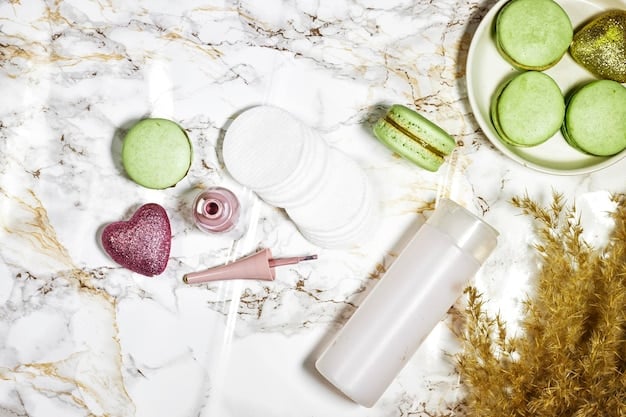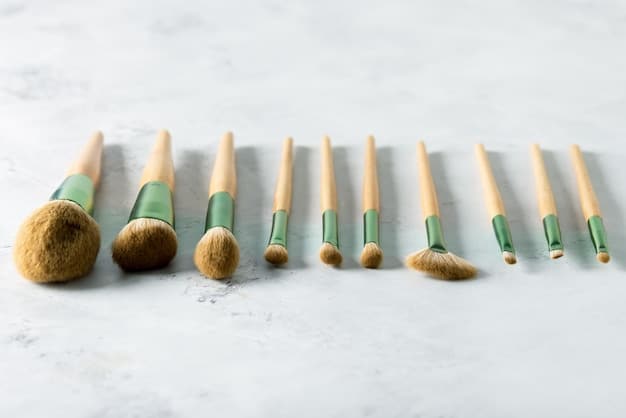Achieve Flawless Foundation: 2025 Application Guide

Achieving a flawlessly applied foundation across all skin types in 2025 involves understanding skin preparation, selecting the right formula for your unique needs, mastering specific application techniques, and utilizing proper setting methods to ensure lasting wear and a natural finish.
In the evolving world of beauty, mastering the art of foundation application is paramount for anyone seeking a polished and radiant complexion. This comprehensive guide, “Achieve a Flawless Base: The Ultimate Guide to Foundation Application for All Skin Types in 2025,” delves into the nuances of selecting, applying, and maintaining your foundation, ensuring a perfect canvas regardless of your skin type. Prepare to transform your makeup routine with expert insights and practical, up-to-date techniques.
Understanding Your Skin Type: The First Step to Foundation Perfection
Before you even consider shade matching, truly understanding your skin type is the foundational step to achieving a flawless base. Skin is dynamic, and what works for one person might be entirely unsuitable for another. Recognizing whether your skin is oily, dry, combination, sensitive, or mature will dramatically influence your foundation choice and application method, ensuring longevity and a perfected look.
Oily Skin: Managing Shine and Longevity
Oily skin types are characterized by excess sebum production, leading to shine, larger pores, and sometimes a tendency for makeup to break down quickly. For those with oily skin, the goal is to control oil without stripping the skin, which can paradoxically trigger more oil production. Look for foundations that are mattifying, oil-free, and long-wearing.
- Primer Matters: An oil-controlling or mattifying primer creates a barrier and helps the foundation adhere better.
- Formulation Focus: Opt for liquid, powder, or stick foundations with matte or semi-matte finishes. Formulas labeled “long-wear” or “oil-free” are your best friends.
- Application Technique: Less is often more. Apply in thin layers, building coverage only where needed. A damp beauty sponge can help sheer out heavier formulas, while a dense brush can provide more controlled coverage.
Dry Skin: Hydration and Radiant Finish
Dry skin often feels tight and may show flakiness, requiring foundations that provide hydration and a luminous finish to prevent clinging to dry patches. The biggest challenge for dry skin is avoiding foundations that enhance texture or leave a dull appearance. Hydration is key, both in skincare and foundation choice.
- Hydrating Base: A rich moisturizer and a hydrating primer are essential. Consider facial oils for an extra boost of dewiness.
- Creamy Formulations: Liquid, cream, or stick foundations with dewy, satin, or luminous finishes are ideal. Avoid anything overtly matte or powder-based, which can exacerbate dryness.
- Gentle Application: Use a damp sponge or your fingertips to gently press the foundation into the skin, avoiding any dragging motions that might emphasize dry areas.
Combination skin presents a unique challenge, with oily zones (typically the T-zone) and drier areas (cheeks, jawline). The strategy here is to balance both needs. Sensitive skin requires gentle, non-comedogenic formulas free of common irritants, while mature skin benefits from hydrating, non-creasing foundations that don’t settle into fine lines. By understanding these distinctions, you set the stage for a foundation application that truly complements your complexion.
Prepping Your Canvas: The Essential Skincare Regimen
No matter how expensive or high-quality your foundation, its appearance is only as good as the canvas it’s applied to. A meticulous skincare regimen is not just about healthy skin; it’s about creating the optimal surface for seamless foundation application. This crucial preparation phase ensures your makeup applies smoothly, wears longer, and looks more natural throughout the day.
Cleansing and Toning: The Fresh Start
Begin with a clean slate. Gently cleanse your face to remove any dirt, oil, or residual products. Follow with a toner. For oily skin, a balancing toner can help minimize pores; for dry or sensitive skin, a hydrating, alcohol-free toner is preferable. This step ensures an even texture and prepares the skin to absorb subsequent products more effectively.
Moisturizing: The Hydration Imperative
Moisturizer is non-negotiable for all skin types. Even oily skin needs hydration to prevent it from overcompensating and producing more oil. For dry skin, a richer, more emollient moisturizer creates a plump, smooth surface. For oily or combination skin, a lightweight, non-comedogenic gel or lotion works best. Apply your moisturizer and allow it to fully absorb for at least 5-10 minutes before moving on to the next step. This prevents pilling and ensures the foundation adheres properly.
Primer: The Secret to Longevity and Smoothness
A primer acts as a bridge between your skincare and makeup, optimizing foundation wear and finish. The type of primer you choose should align with your skin type and desired outcome. There are primers for every concern:
- Hydrating Primers: Ideal for dry or mature skin, they add an extra layer of moisture and create a dewy finish.
- Mattifying Primers: Perfect for oily skin, they control shine and blur pores, extending foundation wear.
- Color-Correcting Primers: Address specific concerns like redness (green), sallowness (lavender), or dullness (peach).
- Smoothing/Blurring Primers: Minimize the appearance of pores and fine lines, creating a silky-smooth canvas.
Applying primer evenly, focusing on areas of concern, will make a noticeable difference in how your foundation looks and lasts. Think of your skin prep as laying a high-quality foundation for your actual foundation – a step that pays dividends in the final aesthetic. 
Selecting the Perfect Foundation: Shade, Undertone, and Formulations
Choosing the right foundation extends far beyond simply picking a shade that looks close to your skin. It involves a nuanced understanding of undertones, coverage levels, and formulations that complement your skin type and lifestyle. The perfect match should blend seamlessly, becoming an undetectable second skin.
The Art of Shade Matching: Testing in the Right Spot
Avoid testing foundation on your hand or wrist, as these areas often differ in tone from your face and neck. The best place to test is along your jawline, blending a small amount down onto your neck. Allow it to oxidize for a few minutes, as some foundations darken slightly on contact with the air and your skin’s oils. The ideal shade should disappear into your skin, leaving no stark line or noticeable discrepancy between your face and neck.
Understanding Undertones: Warm, Cool, and Neutral
This is where many go wrong. Undertones refer to the subtle colors beneath your skin’s surface, not the surface color itself. They are what give your skin its overall hue:
- Cool Undertones: Skin may appear pink, rosy, or blueish. Veins on your wrist often look purple or blue. You might burn easily in the sun.
- Warm Undertones: Skin may appear golden, peachy, or yellow. Veins on your wrist often look green. You might tan easily.
- Neutral Undertones: A mix of both warm and cool, or neither is dominant. Veins may appear a mix of blue/green.
Most foundation lines offer shades categorized by undertone (e.g., C for Cool, W for Warm, N for Neutral). Knowing your undertone will help narrow down your shade choices significantly, preventing you from looking ashy or too orange.
Exploring Foundation Formulations and Coverage Levels
Foundations come in a diverse range of formulas, each designed to deliver specific benefits and finishes. The choice should align with your skin type and the desired coverage.
- Liquid Foundations: The most versatile, ranging from sheer to full coverage, and available in various finishes (matte, satin, dewy). Great for most skin types, depending on the specific formula.
- Cream Foundations: Offer medium to full coverage with a generally hydrating, sometimes luminous finish. Excellent for dry or mature skin.
- Stick Foundations: Convenient for on-the-go application, they offer medium to full coverage. Can be matte or dewy, suitable for spot concealing, and surprisingly versatile for different skin types if blended well.
- Powder Foundations: Provide light to full coverage and a matte finish. Best for oily skin or those preferring a quick, less liquid application. Can sometimes emphasize dry patches.
- Tinted Moisturizers / BB/CC Creams: Offer minimal to light coverage, enhancing natural skin tone rather than concealing. Ideal for those seeking a “no-makeup” look or extra hydration.
When selecting, consider the level of coverage you desire – sheer for a natural look, medium for evening out tone, or full for maximum correction. A practical approach often involves having a few options that cater to different occasions or skin conditions, rather than a single “holy grail.”
Application Techniques: Brushes, Sponges, and Fingertips
The right tools and techniques can make all the difference in how seamlessly your foundation blends and appears on your skin. Each method offers a unique finish and level of coverage, allowing you to tailor your application to your desired outcome and skin type.
The Versatility of Brushes
Makeup brushes provide precision and a controlled application, allowing you to build coverage effectively. Various brush types cater to different foundation formulas and finishes:
- Flat-Top Kabuki Brush: Dense and flat, these brushes are excellent for buffing in liquid or cream foundations, providing a medium to full coverage with a smooth, airbrushed finish. Their dense bristles prevent streaking.
- Stippling Brush: Features two lengths of bristles (dense and sparse) which allow for a more diffused application. Ideal for achieving sheer to medium coverage with a natural, dewy look, especially with liquid or cream formulas.
- Dome-Shaped/Fluffy Brush: Softer and less dense, these are great for applying powder foundations or finishing powders, providing light coverage and a diffused look.
When using a brush, apply foundation in small sections, buffing in circular motions or light strokes to blend seamlessly into the skin. This technique ensures an even application and prevents product buildup in certain areas.
The Popularity of Beauty Sponges
Damp beauty sponges have become a staple for many, offering a natural, skin-like finish. When damp, these sponges expand, becoming softer and less absorbent, allowing them to deposit foundation rather than soak it up. They are particularly effective for blending out liquid and cream foundations, providing adjustable coverage.
- Damp Application: Always use a damp sponge. Squeeze out excess water until it’s just lightly moist.
- Bouncing Motion: Apply foundation by gently bouncing or dabbing the sponge across your face. Avoid dragging or wiping motions, as this can create streaks and uneven coverage.
- Buildable Coverage: The sponge allows for super sheer application with a single layer, or you can build up to medium coverage by adding more product in areas that need it, like around the nose or chin. The dampness helps sheer out heavier formulas, preventing a cakey look.
The Simplicity of Fingertips
For a truly natural, second-skin finish, using your fingertips can be highly effective, especially with liquid or cream formulas. The warmth from your fingers helps to melt the product into the skin, ensuring a seamless blend.
- Warmth Boost: The natural warmth of your fingertips helps foundation to spread easily and blend effortlessly.
- Light Coverage: This method typically yields lighter coverage, making it ideal for everyday wear or when you want your natural skin to show through.
- Blend Out: Begin by dotting foundation onto your face, then use your ring or middle finger to gently pat and blend, working from the center of your face outwards. Pay special attention to the hairline, jawline, and around the nose for a seamless transition.
Often, a combination of tools works best. For instance, you might use a brush to apply foundation, then go over it with a damp sponge to press it into the skin and remove any excess for a perfected finish. Experimentation is key to finding the method that works best for you and the foundation you’re using. 
Concealing and Correcting: Beyond Foundation
While foundation provides an even base, it often requires assistance from concealers and color correctors to address specific imperfections. This layered approach ensures that once your base is set, any remaining concerns are subtly neutralized, leading to a truly flawless complexion without the need for thick, heavy foundation layers.
Color Correcting: Neutralizing Discoloration
Color correctors use the principle of complementary colors to neutralize unwanted tones in the skin before foundation is applied. They are applied sparingly only to the areas of concern, typically after primer but before foundation.
- Green: Neutralizes redness (acne, rosacea, broken capillaries).
- Peach/Orange: Corrects blue or purple dark circles and hyperpigmentation on medium to deep skin tones.
- Yellow: Brightens dullness and can conceal mild redness.
- Lavender: Counteracts sallowness or yellow undertones, adding brightness.
Apply a tiny amount of color corrector directly onto the discoloration and gently tap to blend the edges, taking care not to spread the product beyond the area it needs to address. The goal is to cancel out the color, not to cover it completely at this stage.
Concealer: Targeting Imperfections
Concealer is your go-to for covering blemishes, dark circles, and other imperfections that foundation alone might not fully obscure. Like foundation, concealers come in various formulas and coverage levels.
- For Blemishes: Choose a concealer that matches your foundation shade or is slightly darker for a more natural look. Apply directly to the blemish and pat gently with a clean finger, small brush, or a precise edge of a damp sponge to blend the edges.
- For Under-Eye Circles: Select a concealer that is one shade lighter than your foundation to brighten the area. Formulas designed specifically for the under-eye are often more hydrating and less prone to creasing. Apply in an inverted triangle shape beneath your eye, then blend outwards with a damp sponge or ring finger. This technique helps to brighten a larger area and avoid a stark line under the eye.
- Coverage Levels: Concealers range from light to full coverage. Light to medium coverage is usually sufficient for subtle dark circles, while full coverage is needed for significant discoloration or active blemishes. Liquid and cream concealers are most common, with stick and pot formulations offering higher coverage.
The key to effective concealing is to use minimal product and blend meticulously. After applying and blending your concealer, you can gently pat a small amount of foundation over it if needed, or proceed to setting your base. The combined effort of color correcting and concealing, when done thoughtfully, results in a uniform and radiant complexion without a heavy feel.
Setting Your Foundation: Longevity and Finish
Once your foundation and concealer are perfectly applied, the next critical step is setting your makeup. This ensures longevity, controls shine, and helps to create a seamless, perfected finish that lasts throughout the day, preventing smudging or creasing.
Powder Power: Choosing the Right Formula
Setting powder is the most common method for locking in liquid or cream foundations. Different types yield different results:
- Translucent Powder: A clear, finely milled powder that sets makeup without adding significant coverage or color. Ideal for all skin tones, especially if you’ve already achieved your desired coverage and shade match.
- Colored Powder: Offers a slight tint, adding a touch more coverage while setting. Can be useful if you need minor additional evening out of skin tone. Choose one that matches your foundation shade.
-
Pressed vs. Loose Powder:
- Loose Powders: Generally lighter in texture and provide a more natural, airy finish. Excellent for overall setting and baking (a technique for intense oil control and brightening).
- Pressed Powders: More portable and offer a bit more coverage. Ideal for touch-ups throughout the day or for a quick set.
For oily skin, focus on mattifying powders and apply generously, particularly in the T-zone. For dry or mature skin, use powder sparingly, only in areas prone to creasing (like under the eyes) or slight shine. Over-powdering dry skin can emphasize texture and make makeup look cakey.
Application Techniques for Setting Powder
The way you apply setting powder influences its effect. Precision and moderation are key.
- Powder Puff/Sponge: For targeted application and maximum longevity, especially for areas like the under-eye or T-zone. Press the powder into the skin rather than sweeping.
- Fluffy Powder Brush: For an all-over, lighter set. Swirl the brush into the powder, tap off excess, and lightly dust over your face in sweeping motions.
- Baking: A technique where you apply a thick layer of loose powder to areas you want to brighten and set (e.g., under eyes, chin, forehead) and let it sit for 5-10 minutes. The warmth from your skin “bakes” the product, creating a super long-lasting, creaseless finish. Then, dust off the excess. Best for oily skin or those wanting a very matte, bright look in specific areas.
Setting Sprays: The Final Lock
Setting sprays are an often-underrated final step that melts powders into the skin, removes any powdery finish, and locks your makeup in place, significantly extending its wear. They come in various finishes:
- Matte Setting Sprays: For oily skin and to control shine throughout the day.
- Dewy/Hydrating Setting Sprays: For dry or normal skin, adding a natural radiance and preventing a flat look.
- Long-Lasting Setting Sprays: Formulated to create a strong, flexible film over makeup, ensuring it withstands elements and touches.
Hold the bottle about 8-10 inches away from your face and spray in an “X” and “T” motion, ensuring even coverage. Allow it to air dry naturally. This final step not only ensures your foundation lasts, but also gives it a more skin-like, polished appearance. When properly set, your flawless base will withstand the demands of your day, maintaining its perfection from morning to night.
Troubleshooting Common Foundation Woes
Even with the best products and techniques, sometimes foundation doesn’t perform as expected. Addressing these common issues requires a systematic approach, often tracing back to preparation, product choice, or application. Understanding how to troubleshoot ensures you can always achieve that desired flawless finish.
Cakey or Heavy Foundation
A “cakey” look is usually due to too much product, inadequate blending, or inappropriate formula for your skin type.
- Solution: Start with less product. Apply in thin layers and build coverage only where needed. Ensure your skin is well-hydrated before applying makeup. If using a brush, buff the foundation into the skin thoroughly. If using a sponge, ensure it’s damp and that you’re bouncing, not dragging. Consider a lighter coverage foundation for everyday wear. For dry skin, avoid heavy matte formulas.
Foundation Oxidizing (Turning Orange)
Oxidation happens when foundation interacts with your skin’s oils and the air, causing it to darken or turn an orange hue.
- Solution: The best defense is to test foundation on your jawline and wait 10-15 minutes before purchasing to see how it oxidizes. Some mattifying and oil-free primers can help create a barrier. Using a setting spray can also reduce oxidation. For oily skin, managing sebum production with a good skincare routine and mattifying primers/powders can lessen the effect.
Foundation Settling into Fine Lines or Pores
This is often a result of dry skin, excess product, or insufficient blending, especially around expression lines or larger pores.
- Solution: Ensure skin is adequately moisturized and consider a blurring or pore-filling primer in areas of concern. Apply foundation thinly in these areas. Instead of wiping, pat or press the product into the skin. Lightly set with a translucent powder using a small brush or damp sponge to press the powder in, then dust off any excess. Use a hydrating setting spray to melt the powder into the skin.
Foundation Sliding Off or Breaking Apart
This happens when foundation loses its adherence to the skin, often in oily areas or due to environmental factors.
- Solution: A mattifying primer is crucial for oily skin. Use long-wear or oil-free foundation formulas. Ensure you’re setting your foundation with powder, especially in areas prone to oil, and follow with a good setting spray. Blotting papers throughout the day can manage excess oil without disturbing makeup.
By identifying the root cause of these common issues, you can fine-tune your application process and product choices, ensuring your foundation remains flawless and wears beautifully throughout the day, adapting to any challenge your skin or environment presents.
Future of Foundation: Innovations in 2025 and Beyond
The beauty industry is in a constant state of evolution, and foundation technology is no exception. As we look towards 2025 and beyond, several key trends and innovations are shaping the future of achieving a flawless base, focusing on enhanced performance, customization, and ethical considerations. The landscape is moving towards products that are smarter, more inclusive, and better for both our skin and the planet.
Skincare-Infused Foundations
The line between skincare and makeup continues to blur. Foundations are increasingly formulated with active skincare ingredients, offering benefits beyond mere coverage. Expect to see more foundations with:
- Hyaluronic Acid: For intense hydration and a plumping effect.
- Niacinamide: To improve skin texture, reduce inflammation, and minimize pores.
- Antioxidants (Vitamins C & E): To protect against environmental damage and brighten the complexion.
- SPF: Higher and more effective broad-spectrum UV protection integrated seamlessly into formulas.
This trend means your foundation isn’t just about aesthetics; it’s actively contributing to the health and improvement of your skin over time, making your daily makeup routine an extension of your skincare regimen.
Hyper-Customization and AI-Powered Matching
The days of struggling to find the perfect shade might soon be over. AI and advanced color-matching technologies are becoming more sophisticated and accessible:
- At-Home Devices: Devices that scan your skin to recommend or even custom-blend foundation shades directly for you.
- Virtual Try-On: Augmented reality applications are getting better at simulating how different shades and finishes will look on your face.
- Personalized Formulations: Brands are exploring ways to customize not just the shade but also the finish, coverage, and skincare ingredients in a foundation tailored precisely to an individual’s skin needs and preferences.
This shift promises a truly personalized foundation experience, eliminating guesswork and ensuring a perfect match every time.
Sustainable and Ethical Beauty
Consumers are increasingly demanding transparency and ethical practices from beauty brands. The future of foundation will heavily emphasize:
- Clean Formulations: Products free from potentially harmful chemicals and irritants.
- Sustainable Packaging: Refillable options, recycled materials, and biodegradable components to reduce environmental impact.
- Cruelty-Free & Vegan: A continued strong push towards products not tested on animals and free of animal-derived ingredients.
- Transparency: Brands being more open about their ingredient sourcing, manufacturing processes, and ethical supply chains.
These innovations highlight a future where foundation is not just a cosmetic but an integral part of a holistic approach to skin health, personal expression, and environmental responsibility. Staying informed about these developments will empower you to make smarter choices for your beauty routine in 2025 and beyond.
| Key Point | Brief Description |
|---|---|
| 🧴 Skin Prep | Proper cleansing, moisturizing, and priming are essential for a smooth canvas and extended wear. |
| ✨ Product Selection | Choose foundation based on skin type, undertone, desired coverage, and finish for the best match. |
| 🖌️ Application Tools | Brushes, sponges, or fingertips each offer unique finishes; find what works best for your formula and desired look. |
| 🔒 Setting & Longevity | Powders and setting sprays are vital for locking in foundation, controlling shine, and ensuring all-day wear. |
Frequently Asked Questions About Foundation
▼
To determine your undertone, observe the color of your veins on your inner wrist. Blue or purple veins suggest cool undertones, green veins indicate warm undertones, and a mix of blue-green suggests neutral. You can also consider how your skin reacts to the sun: those who burn easily often have cool undertones, while those who tan easily typically have warm undertones.
▼
Yes, you can often use one foundation for combination skin, but the application technique and pre-makeup prep might differ. Use a mattifying primer on oily zones (like the T-zone) and a hydrating primer on dry areas. You might also apply a lighter layer of foundation where you’re oily and build up more coverage on drier spots to prevent it from looking cakey or emphasizing dry patches.
▼
To prevent a cakey appearance, always start with a well-prepped, moisturized base. Apply foundation in thin layers, building coverage only where needed. Use a damp beauty sponge or a buffing brush for seamless blending, ensuring the product melts into your skin rather than sitting on top. Set sparingly with a finely milled translucent powder, focusing on oily areas, and finish with a setting spray.
▼
For most applications, it’s best to apply foundation first. This provides an overall even base, and you’ll find you need less concealer to cover imperfections once your foundation is on. Apply concealer *after* foundation to target specific areas like blemishes or dark circles, and blend gently to ensure a seamless transition between the two products.
▼
Cleaning your foundation application tools regularly is crucial for hygiene and optimal performance. For daily users, beauty sponges should ideally be washed after each use, or at least every few days. Brushes used for liquid or cream products should be cleaned weekly to prevent bacteria buildup, product accumulation, and to ensure smooth, streak-free application.
Conclusion
Achieving a flawless foundation base in 2025 is an attainable goal for everyone, regardless of skin type. It’s a meticulous process that begins with a deep understanding of your unique skin needs, meticulous preparation, and selecting the right products and tools. By mastering these fundamental steps—from identifying your skin type and undertone to utilizing proper application and setting techniques—you can ensure your foundation not only looks impeccable upon application but also maintains its perfection throughout the day. Embrace the evolving innovations in beauty, and let your foundation truly become a second skin, enhancing your natural radiance.





